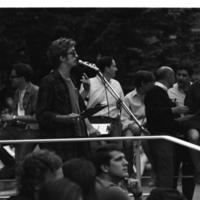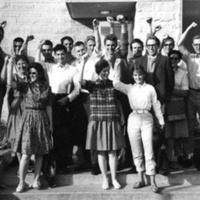Browse Exhibits (2 total)
Interviews

Bill Ayers was a student activist at the University of Michigan from 1964 until 1968. He was present for the first teach-in, arrested for a sit-in at the Ann Arbor Selective Service Office, and later became a leader of the radical group Weather Underground. He participated in various other acts of resistance throughout his undergraduate years at U of M. Bill Ayers now works in education reform and instruction after being a professor at the College of Education at the University of Illinois, Chicago.
Frithjof Bergmann was a professor of philosophy at the University of Michigan from 1959 until 1999. He specialized in existentialism and had intellectual influence on the members and events of the anti-Vietnam War movement. Professor Bergmann was a part of the original small group of professors who created the idea of the teach-in. He then was a speaker and leader of the University of Michigan Teach-in in March 1965. During the rest of the Vietnam War, Professor Bergmann was a member of protests on campus in the form of teach-ins, take overs of the ROTC building, the Radical College, and the hunger fast against classified research at the University of Michigan. Today, he is a Professor Emeritus at the University of Michigan as well as a leader of the organization, New Work, which focuses on innovative forms of employment for our current job system.
Bill Gamson was a sociology professor at the University of Michigan from 1962 until 1982. He was a leader and organizer of the 1965 anti-Vietnam War teach-in at U of M. Professor Gamson continued to participate in anti-war sentiment and protest throughout the 60s and early 70s. He even lead a fast by university professors against University involvement in military research. His wife, Zelda Gamson, was also an active participant and was specifically involved in the 1971 March on Washington. Currently, Professor Gamson is a sociology professor at Boston College where he still continues to study social movements.
Tom Hayden was an undergraduate student at the University of Michigan from 1957 until 1961 and then a graduate student from 1963 until 1964. He was a writer and editor-in-chief of the Michigan Daily as well as a founder and president of Students for a Democratic Society. Tom Hayden was the writer of the first draft of the Port Huron Statement as well as a participant in the discussions that constructed the final draft of the Statement in June 1962. Hayden was a Freedom Rider during the Civil Rights Movement and a community organizer in the inner city of Newark, New Jersey through the SDS program, ERAP. He was a continual activist against the Vietnam War through teach-ins, sit-ins, marches, and a long list of other forms of protest. Hayden helped with the release of three American POWs in Hanoi and was one of the leaders of the 1968 Democratic National Convention protests in Chicago. He was later a member of the Chicago 8 Trial for his activities during the protests in Chicago. Since the anti-Vietnam War Movement, Tom Hayden has been a California Assemblyman and Senator, activist, teacher, and writer.
Richard Mann was a Professor of Psychology and Religion at the University of Michigan from 1964-1992. Among many anti-war activities, he participated in the Teach-in of 1965, played a large role in the Inter-University Committe where he helped convince a Special Assistant to the National Security Advisor, McGeorge Bundy, to participate in a CBS televised debate about the Vietnam War, and participated in the planning of the National Teach-in. Professor Mann is a Professor of Emeritus at the University of Michigan, but still occasionally teaches classes at U of M.
Tom Mayer was a professor at the University of Michigan from 1964 until 1969 and taught classes on sociology, mathematical modeling, social change, analysis of revolutions, and Marxist theory. Professor Mayer was a speaker at the original 1965 Teach-in, as well as several other teach-ins at the University of Michigan throughout the Vietnam War. He was also a participant of the 1965 Selective Service Sit-in, which he served several days in jail for in consequence. Professor Mayer was active throughout his time at the University of Michigan in anti-war protests. In 1969, he did not receive tenure from the University. Professor Mayer then moved to teach at the University of Colorado, Boulder, where he continued being involved in anti-war and social justice activism.
Paul Milgrom was a student-activist at the University of Michigan from 1966-1970. As he persued an A.B. in Mathematics, he also became involved in anti-war activities on campus. Professor Milgrom participated by organizing anti-war rallies, serving on the Student Government Council who organized students, and handed out anti-war literature at his draft physical. He was also involved in other social movements on campus, for example the welfare-rights sit-in, which resulted in his arrest and sentence of 10 days on a work crew. Currently, Professor Milgrom is a professor in the Economics Department at Standford University.
Marshall Sahlins was a Professor of Anthropology at the University of Michigan from 1956-1967. He developed the idea of a "teach-in" which led to the 1965 Teach-in at U of M. He led, participated and organized the 1965 Teach-in as well as the National Teach-in that followed soon after. He left U of M in 1967 and spent the next two years in France where he continued to protest the Vietnam War. Following his time in France, he accepted a position in the Anrthopology Department at the University of Chicago. Professor Sahlins is currently a Charles F. Grey Distinguished Service Professor of Anthropology Emeritus at the University of Chicago.
John Vandermeer attended the University of Michigan as a graduate student from 1966 until 1970 studying Biology. He was a participant in the anti-Vietnam War Movement on the University of Michigan campus. Professor Vandermeer was a founding member of the Ann Arbor chapter of Science for Peace, which is a coalition of scientists, engineers, social scientists, and academics who work together in order to promote peace and prosperity worldwide. John Vandermeer later became an activist against the United States wars in Central America. He is now a professor of Ecology and Evolutionary Biology at the University of Michigan, a member of the New World Agriculture and Ecology Groups, and is an active participant in the environmental movement.
Harvey Wasserman was a student at the University of Michigan from 1963 until 1967. He was a member of the Michigan Daily and covered many of Vietnam War protests on campus for the paper. Harvey Wasserman was also a participant of the anti-Vietnam War movement on the University of Michigan campus as a member of Students for a Democratic Society. Harvey Wasserman is now a journalist, author, democracy activist, and advocate for green energy. He is a senior advisor for Greenpeace and an anti-nuclear power activist.
Exhibit

Today, the University of Michigan is known for its long standing history of student activism and its prominent role in Anti-Vietnam War Movement. The 1960s was an era filled with youth that had a desire to voice their discontent towards the government. As a result, various social movements formed and intersected with one another. On college campuses across the nation, the oppression of civil and free speech rights became a main concern. In 1965, another issue was brought to campus with President Johnson’s unexpected escalation of the Vietnam War. Escalation meant an increase in draftees, which made the Vietnam War a more tangible issue for the youth. The Student Nonviolent Coordinating Committee (SNCC), Students for a Democratic Society (SDS), and the Free Speech Movement at UC-Berkeley, acted as an inspiration and a foundation for anti-war activism at the University of Michigan.
The first prominent University of Michigan anti-war activism occurred in March 1965. Receiving resistance for their original idea of a strike, faculty members at Michigan innovated the idea of a teach-in to educate students on U.S. foreign policy in Vietnam. Teach-ins quickly spread to campuses across the nation. Eventually, faculty leadership transferred to the students as they continued to stimulate not only local, but national attention as well. With the movement in the hands of students, the anti-war tactics quickly shifted from intellectual conversation to direct action. Direct action came in the form of a sit-in at the Selective Service Office in October 1965. It resulted in the arrest and reclassification of several University of Michigan students. The continuation of direct-action protests resulted in a push to force university divestment and military research/recruitment. As direct action protests became more militant and the ideological roots of the movement were lost, the war still dragged on. Even still, the efforts of the Anti-Vietnam War Movement resulted in open dialogue between students, faculty, university administrators and the government about foreign affairs issues. A concept very few could have predicted prior to the 1960s.
This exhibit begins with origination of the New Left, in the early 1960s, and explores the tactics used by anti-war activists from 1965-1972. The tabs on the right provide an outline of key episodes of the anti-Vietnam War movement--from the origination of the New Left, to using intellectualism as a form of speaking out against the war, to the direct action and resistance of the draft, to disrupting the University’s involvement in the war. The legacies section considers the impact of the anti-Vietnam War movement at the local and national levels from the perspective of organizers and participants. For the first time, this website explores the political activism and intellectual discussions that took place on the University of Michigan’s campus during the Vietnam War era.
Featured Exhibit
You have no featured exhibits.
